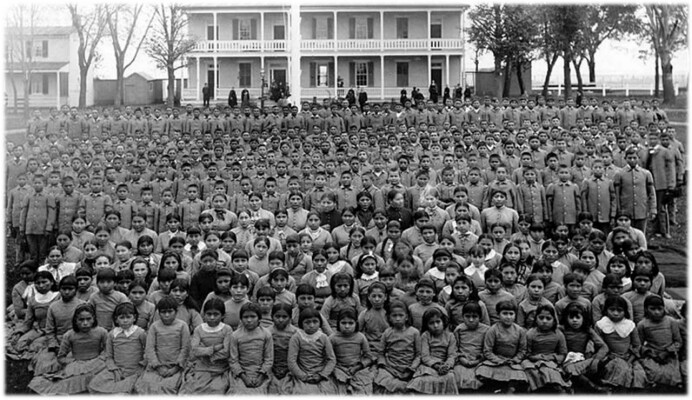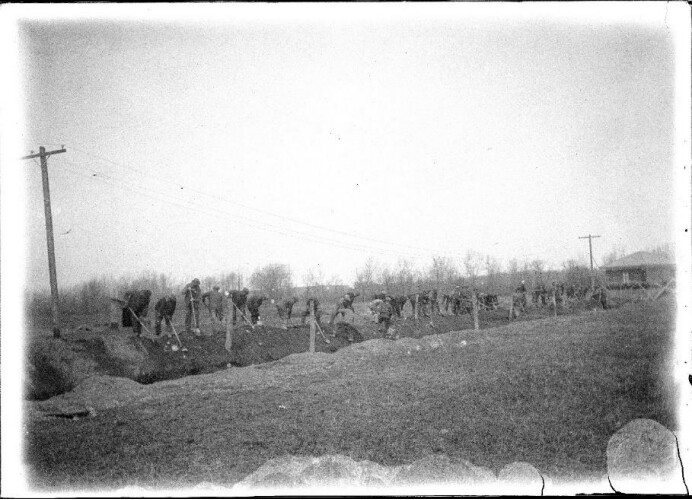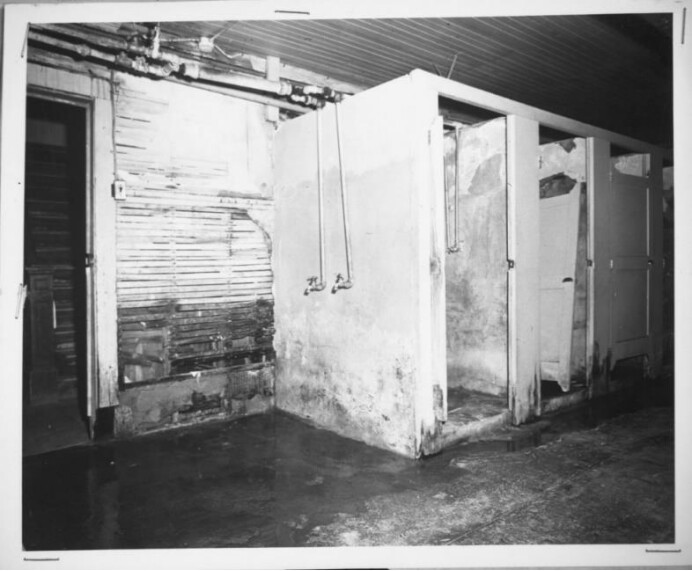"It's a lifelong scar. It's a lifelong wound," said Ramona Klein, a 77-year-old American Indian woman when looking back at her experiences at a former Indian boarding school in North Dakota.
At least 973 American Indian, Alaska Native, and Native Hawaiian children died while attending Federal Indian boarding schools in the U.S., and at least 74 marked and unmarked burial sites were found at 65 different school sites, according to an investigation released in July 2024 by the U.S. Department of the Interior. Klein's experiences epitomize the tragic history of these boarding schools.
The investigation is an effort made by the federal Indian Boarding School Initiative, which was announced by U.S. Secretary of the Interior Deb Haaland in June 2021 and aims to address the intergenerational impact of U.S. federal Indian boarding school policies.

Carlisle Indian School student body around 1885, with the Superintendent's House in background. (Photo/Federal Indian Boarding School Initiative Investigative Report)
What is federal Indian boarding school system?
Between 1819 and the 1970s, the U.S. implemented policies to establish and support Indian boarding schools across the nation, in a bid to culturally assimilate American Indian, Alaska Native, and Native Hawaiian children by forcibly removing them from their families, communities, languages, religions, and cultural beliefs. While attending these boarding schools, many children endured physical and emotional abuse and, in some cases, died.
The curriculums of the boarding schools were rooted in linguistic imperialism, the English-only movement, and forced assimilation, which were enforced through corporal punishment.
The assimilation methods deployed included renaming Indian children with English names, cutting the hair of Indian children, discouraging or preventing the use of American Indian, Alaska Native, and Native Hawaiian languages, religions, and cultural practices, and organizing Indian and Native Hawaiian children into units to perform military drills.
Manual labor, such as livestock and poultry raising, western agriculture production, lumbering, and brick-making, was also included in the curriculum, which left American Indian, Alaska Native, and Native Hawaiian graduates with employment options often irrelevant to the industrial U.S. economy, further disrupting Tribal economies, according to the Federal Indian Boarding School Initiative Investigative Report.
The U.S. Government was responsible for operating or overseeing Indian boarding schools across the country and its territories and made appropriations available of more than $23.3 billion in FY23 inflation-adjusted dollars between 1871 and 1969 to run the schools and associated assimilation policies. 417 boarding schools have been found across 37 states or then-territories.

Students of a federal Indian boarding school working outside. (Photo/Federal Indian Boarding School Initiative Investigative Report)
Why did children die at Indian boarding schools?
The deaths of children at federal Indian boarding schools were primarily due to abuse and disease. The federal Indian Boarding School Initiative Investigative Report shows that children were physically, sexually, and emotionally abused.
School rules were often enforced through punishment, including corporal punishment, such as solitary confinement, flogging, withholding food, whipping, slapping, and cuffing. The schools at times made older Indian children punish the younger ones.
One of the survivors from Wrangell in Alaska said the boarding school "was a place that attracted pedophiles, and many matrons, men and women, perpetrated themselves upon little boys and girls. What I witnessed in the boys' dorm were matrons sodomizing boys in their beds or in the bathrooms. We saw girls going home in the middle of the school year pregnant, and a lot of these children were 11, 12, 13 years old."
The historical trauma of the federal boarding schools and other assimilation-related policies "often impacted several generations" and continues to fuel high suicide rates, drug abuse, alcoholism, and poor parenting among Native Americans and their communities, according to the Investigative Report.
"These are stolen generations of children," said Deborah Parker, a Native American and CEO for the Minnesota-based group.

Shower room in the basement of the girls' dorm at a federal Indian boarding school with a cement floor and leaky water pipes and without heat. During the coldest part of winter, girls are not permitted to shower. (Photo/Federal Indian Boarding School Initiative Investigative Report)
Will U.S. government apologize?
Officials of the U.S. Department of the Interior called on the government to apologize for the boarding school policies and provide compensation for Aboriginal people.
The officials also recommended that the U.S. government invest in programs that could help Native American communities heal from the traumas caused by boarding schools. That includes money for education, violence prevention, and the revitalization of indigenous languages — on a scale commensurate with government spending on the schools.
However, the White House has not responded to a request for comment on the new report or its push for an apology.
"Truth and reconciliation are not beyond our reach," Chase Iron Eyes, executive director of the Sacred Defense Fund, said. "The United States must assist in providing paths to recovery."
Co-presented by GDToday and the School of Journalism and Communication, Jinan University
Reporter | Lydia Liu, Zhan Manqi (intern)
Poster designer | Mia Lai
Editor | Steven Yuen, Nina Huang, James

















